Introduction
Automobiles serve as more than just a means of transportation; they function as personal sanctuaries where comfort and well-being take precedence. With rising temperatures and fluctuating air quality, the demand for effective cooling solutions has never been more critical. Enter car vent fans – these innovative accessories are revolutionizing the driving experience by enhancing air circulation, regulating temperature, and promoting overall health.
But how do these seemingly simple devices address such complex challenges? Are they truly essential for every vehicle? By examining the advantages of car vent fans, we uncover their pivotal role in transforming any journey into a more enjoyable and safe experience.
In the following sections, we will delve deeper into the technical benefits of car vent fans, supported by data and case studies, to illustrate their importance in modern automobiles.
Gagner-Toomey Associates: Innovative Cooling Solutions for Vehicle Comfort
Gagner-Toomey Associates stands at the forefront of innovative cooling technologies, significantly enhancing comfort in automobiles. The challenge of maintaining optimal temperatures inside vehicles is met with advanced cooling solutions, including the car vent fan, that empower engineers to design systems capable of effective temperature regulation. This expertise is particularly crucial in developing automobile air circulation systems that utilize the car vent fan, which play a vital role in improving airflow and ensuring comfortable cabin temperatures.
Consider the impact of contemporary battery cooling systems: they can boost energy efficiency by up to 25% and extend battery lifespan by approximately 40%. Such advancements are not merely enhancements; they are essential for the modern automobile. Successful implementations of these cutting-edge cooling technologies, such as the car vent fan, have proven their effectiveness in creating a more pleasant driving environment, underscoring the critical role of sophisticated thermal management systems in today’s automotive landscape.
In summary, the integration of these innovative cooling technologies is not just beneficial; it is imperative for the future of automotive design. By prioritizing advanced thermal management, manufacturers can ensure a superior driving experience that meets the demands of today’s consumers.
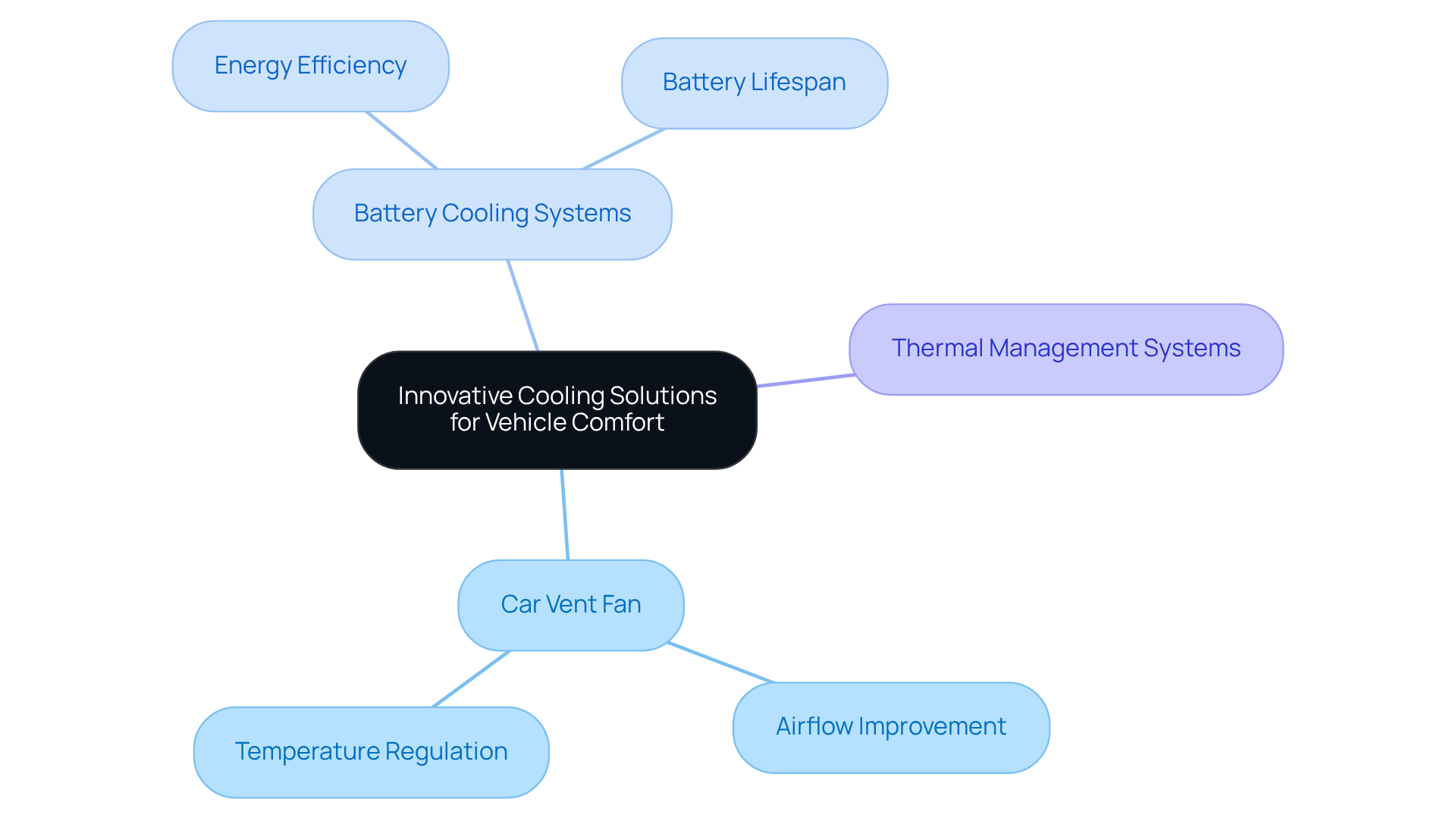
Enhanced Air Circulation: Improve Comfort and Reduce Stale Air
Car vent fans are vital for enhancing airflow within automobiles, actively circulating air throughout the cabin to eliminate stale air and odors. This improved airflow is especially crucial during hot weather, as it helps counteract the rapid decline in air quality inside parked vehicles. Studies reveal that when windows are closed and ventilation is off, air change rates can plummet below one hour, resulting in elevated concentrations of pollutants. Conversely, employing a car vent fan can significantly boost air exchange rates, fostering a fresher atmosphere for passengers.
Real-world examples underscore the effectiveness of car vent fans in maintaining air quality. In heavy traffic scenarios, where air pollution levels can be five to ten times higher than in surrounding areas, these devices play a key role in reducing the concentration of harmful particles within the vehicle. Research indicates that using the air-recirculation function can trap humidity, leading to misted windscreens and discomfort, particularly in cold and wet conditions. However, when combined with car vent fans, air quality can be improved, ensuring a more pleasant driving experience.
Moreover, the strategic use of a car vent fan can enhance the efficiency of the air conditioning system, allowing it to cool the cabin more effectively. This is particularly important during heatwaves, as activating the AC alongside the exhaust systems ensures quicker cooling and increased comfort. Additionally, utilizing the air-recirculation button can lower fuel consumption by supporting the AC system, making it a more efficient choice.
In summary, automotive air circulation systems are essential for maintaining a healthy and enjoyable in-cabin environment, representing a significant advancement in automobile design. To maximize their effectiveness, drivers should regularly switch to fresh air mode, particularly in winter, to prevent humidity buildup and ensure clear visibility.
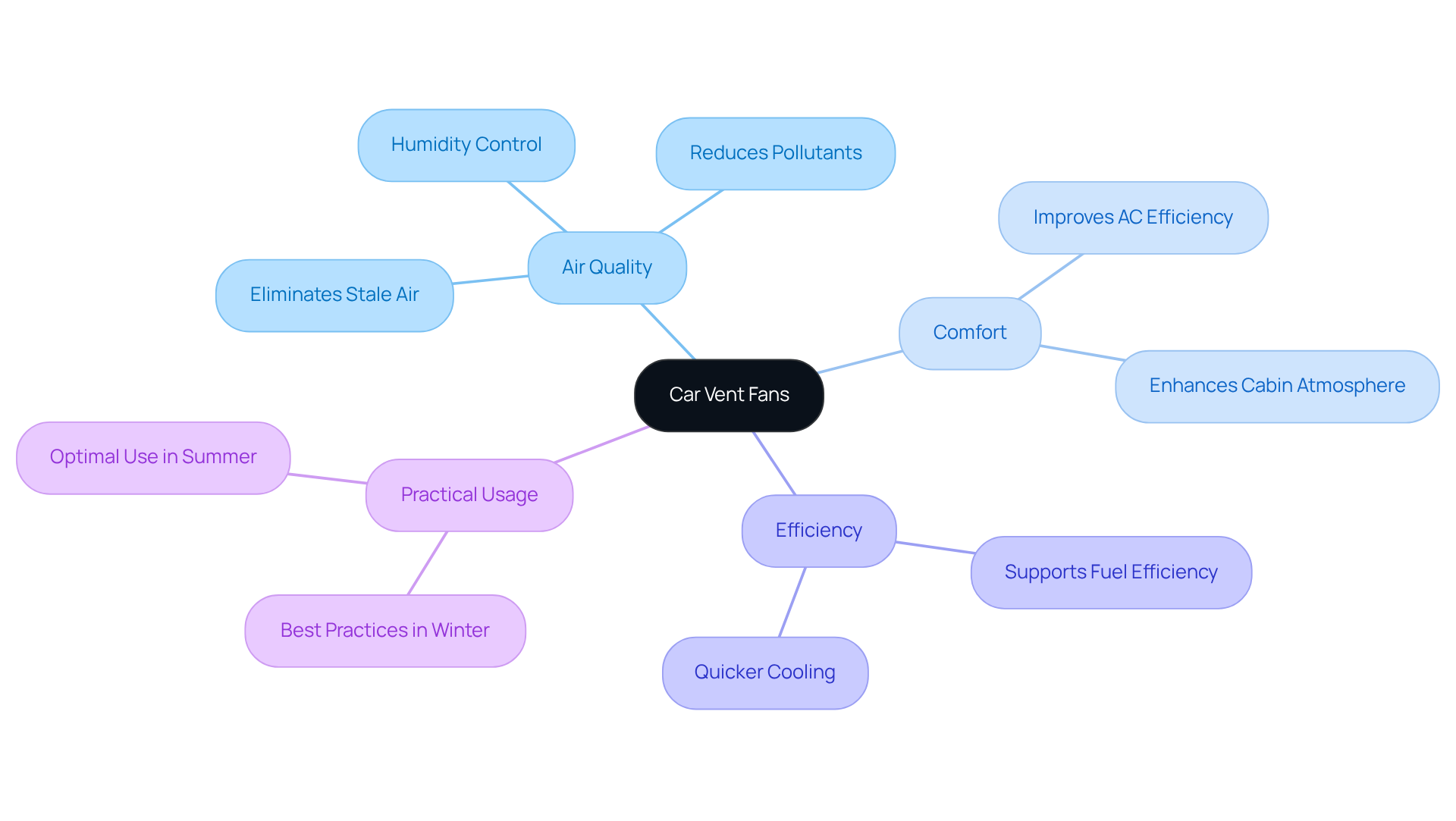
Temperature Control: Maintain a Comfortable Cabin Climate
The car vent fan plays a crucial role in effective temperature regulation, efficiently expelling hot air and drawing in cooler outside air. This function becomes particularly vital after a vehicle has been parked in the sun, where cabin temperatures can reach a staggering 48°C. Research indicates that employing two ventilation devices can achieve a significant 17% reduction in interior temperature. Furthermore, adding a third blower can yield an additional 3.4% decrease, while utilizing four blowers can provide an extra 4.8% reduction. This demonstrates the clear advantages of deploying multiple units. Strategically positioning ventilators, such as in the center of the roof, can also yield comparable results.
By ensuring a comfortable cabin climate, the car vent fan not only enhances the overall driving experience but also reduces reliance on energy-intensive air conditioning systems. Roof ventilation has emerged as the most effective method for energy conservation, achieving a heat removal efficiency of 0.471. This efficiency significantly lowers the head temperature for both the driver and rear passengers, delivering optimal cooling effects.
The importance of cabin climate control cannot be overstated. Advances in thermal management directly contribute to improved fuel efficiency, extended range, and enhanced passenger comfort. One study highlights that effective ventilation strategies can result in a maximum daily average temperature difference of 7.2°C with solar ventilation, compared to a stark 20.6°C without it. This underscores the essential role that exhaust systems play in maintaining a comfortable and secure driving environment.

Health Benefits: Reduce Allergens and Improve Air Quality
Car air circulation systems are essential for enhancing air quality within vehicles, effectively reducing allergens and pollutants. These systems facilitate the movement of fresh air, which helps disperse harmful substances that can accumulate in confined spaces. For example, studies indicate that utilizing fresh air ventilation can significantly decrease in-cabin carbon monoxide (CO) concentrations, keeping levels below 520 ppm at speeds exceeding 40 km/h. However, at speeds below 70 km/h, CO levels can surpass the ASHRAE recommended limit of 1000 ppm, underscoring the critical need for effective ventilation. This is particularly advantageous for passengers with allergies or respiratory conditions, as improved air circulation can alleviate symptoms triggered by airborne irritants.
Real-world examples underscore the efficacy of car vent fans in reducing allergens. In one study, vehicles equipped with efficient ventilation systems exhibited lower concentrations of particulate matter (PM) compared to those relying solely on recirculation. Furthermore, the practice of opening windows in low-traffic areas was found to reduce pollutant levels, highlighting the significance of ventilation strategies in managing indoor air quality (IAQ).
Health specialists emphasize the necessity of maintaining good air quality inside vehicles. It is advisable to regularly alternate between recirculation and fresh air modes to keep CO levels below the ASHRAE threshold of 1000 ppm, with fresh air supplied at a rate of 9.2 L/s for each occupant. This practice is particularly crucial, given that pollution levels inside cars stuck in heavy traffic can be 40 percent higher than when the vehicle is in motion. By prioritizing effective air circulation, the car vent fan not only enhances passenger comfort but also contributes to overall well-being, making it a vital feature in modern vehicles.

Energy Efficiency: Save Fuel and Reduce Environmental Impact
Car vent fans offer a compelling solution to the growing need for energy efficiency in automotive systems. These devices, such as the car vent fan, are engineered to operate with minimal energy consumption, making them a superior alternative to traditional air conditioning systems. By effectively utilizing a car vent fan to circulate air, drivers can significantly reduce their reliance on AC, which not only conserves fuel but also lowers greenhouse gas emissions.
This eco-friendly approach not only addresses environmental concerns but also aligns with the increasing demand for sustainable automotive solutions. As consumers become more environmentally conscious, the adoption of such technologies becomes imperative.
Incorporating a car vent fan into daily driving habits can lead to substantial benefits. Not only do they enhance fuel efficiency, but the use of a car vent fan also contributes to a cleaner environment. By choosing these devices, drivers take a proactive step towards sustainability, demonstrating a commitment to reducing their carbon footprint.
In conclusion, embracing car air circulation devices is not just a choice; it’s a responsibility towards a more sustainable future. As the automotive industry evolves, integrating these innovative solutions will be crucial for both environmental preservation and energy conservation.
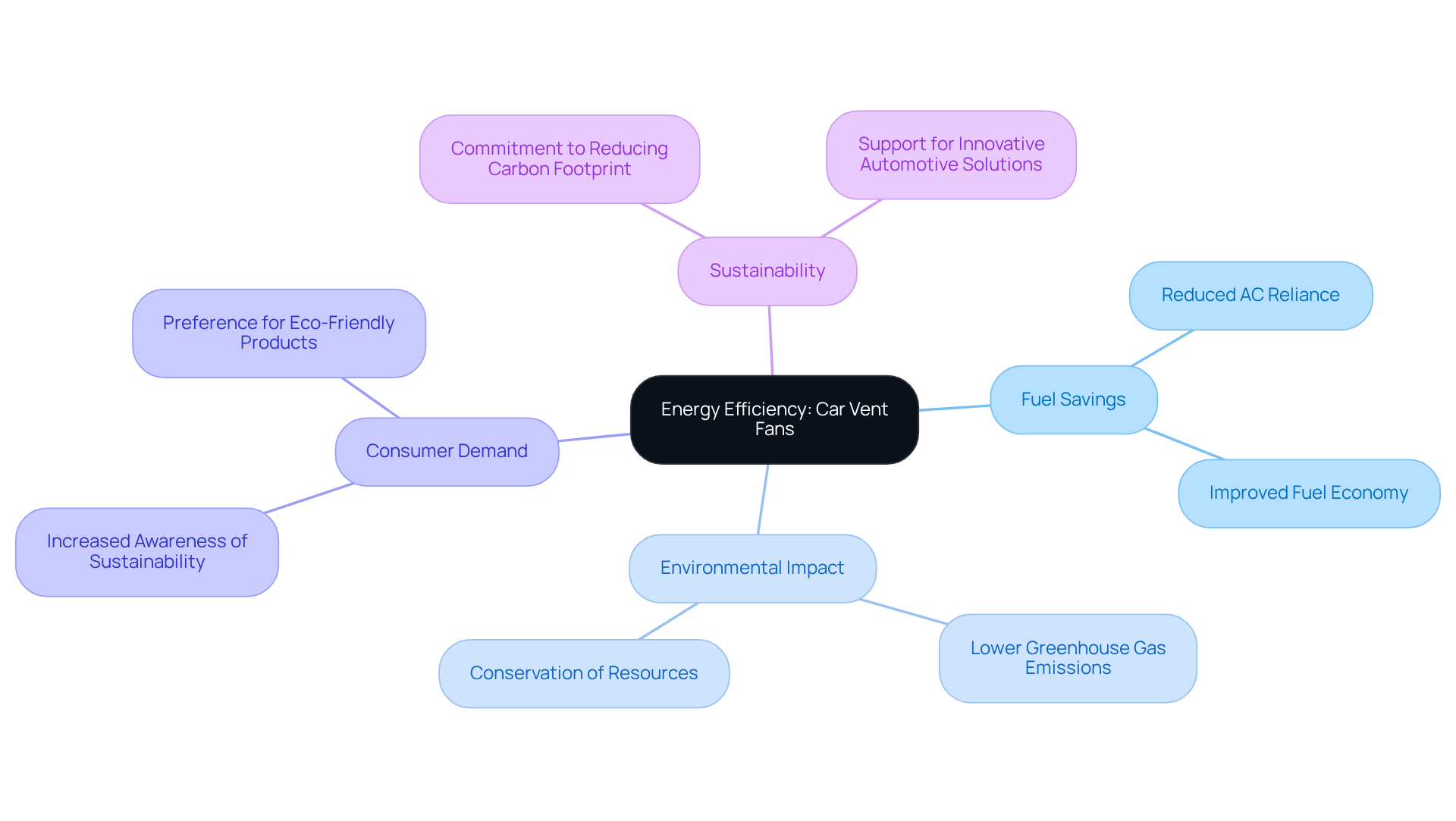
Convenience: Easy Installation and User-Friendly Operation
Car vent fans address a common issue: the need for enhanced comfort in vehicles. Designed for easy setup and user-friendly functionality, these devices have become a favored option among automotive accessories. Most models can be effortlessly installed in existing openings, eliminating the need for complex tools or modifications. This ease of use is complemented by adjustable settings, allowing users to tailor airflow to their specific comfort preferences.
In 2020, several manufacturers introduced smart-controlled ventilation systems with app integration, further enhancing convenience. Such innovations not only simplify operation but also cater to the evolving demands of tech-savvy consumers. As we look ahead, the automotive ventilated seat fan market is projected to grow at a CAGR of 4.3% from 2024 to 2030, driven by increasing consumer demand for comfort features.
This blend of user-friendly attributes and innovative designs establishes the car vent fan as a vital element for improving comfort in automobiles. By investing in these devices, consumers can significantly enhance their driving experience, making every journey more enjoyable.
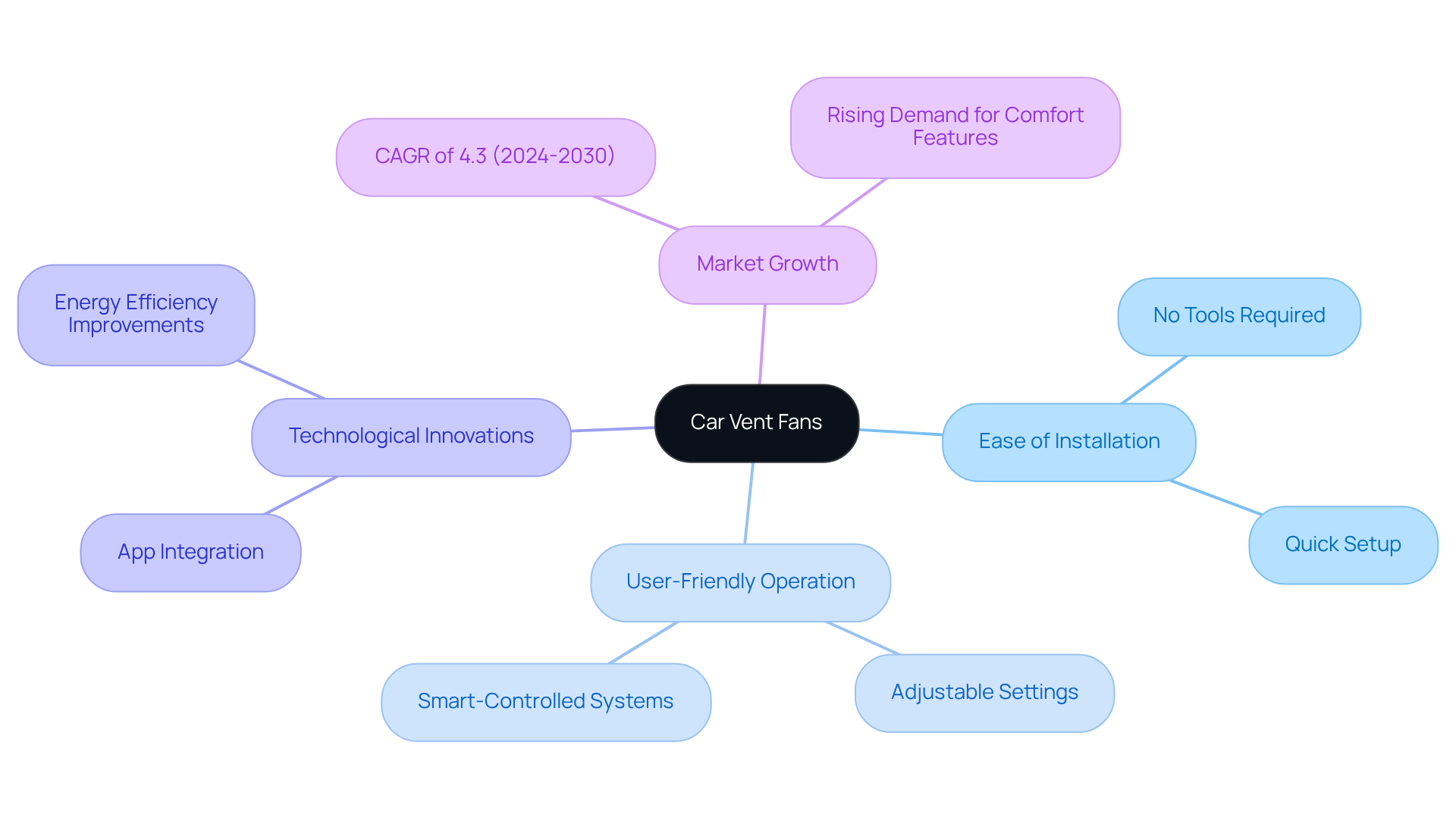
Cost-Effectiveness: Affordable Solution for Vehicle Comfort
Car vent fans offer a cost-effective solution for enhancing vehicle comfort, sidestepping the hefty price tag associated with advanced air conditioning systems. Priced between $20 and $50, these devices are accessible to a wide range of consumers. They efficiently circulate air, delivering a refreshing breeze that significantly improves the driving experience, particularly in hot weather. Notably, the operational cost of these cooling devices is substantially lower than that of air conditioning, with continuous use likely costing less than $10 per month.
For example, popular models such as the Vornado VFan and the BREEZE car fan stand out for their efficiency and affordability:
- The Vornado VFan boasts a classic design coupled with powerful airflow.
- The BREEZE car fan is compact and straightforward to install.
By investing in a car vent fan, drivers can enjoy a more comfortable ride while managing expenses, making it an intelligent choice for budget-conscious consumers.
It’s essential to remember that these cooling devices should only be used when individuals are inside the vehicle to optimize energy conservation. This practice not only enhances comfort but also promotes responsible energy use.
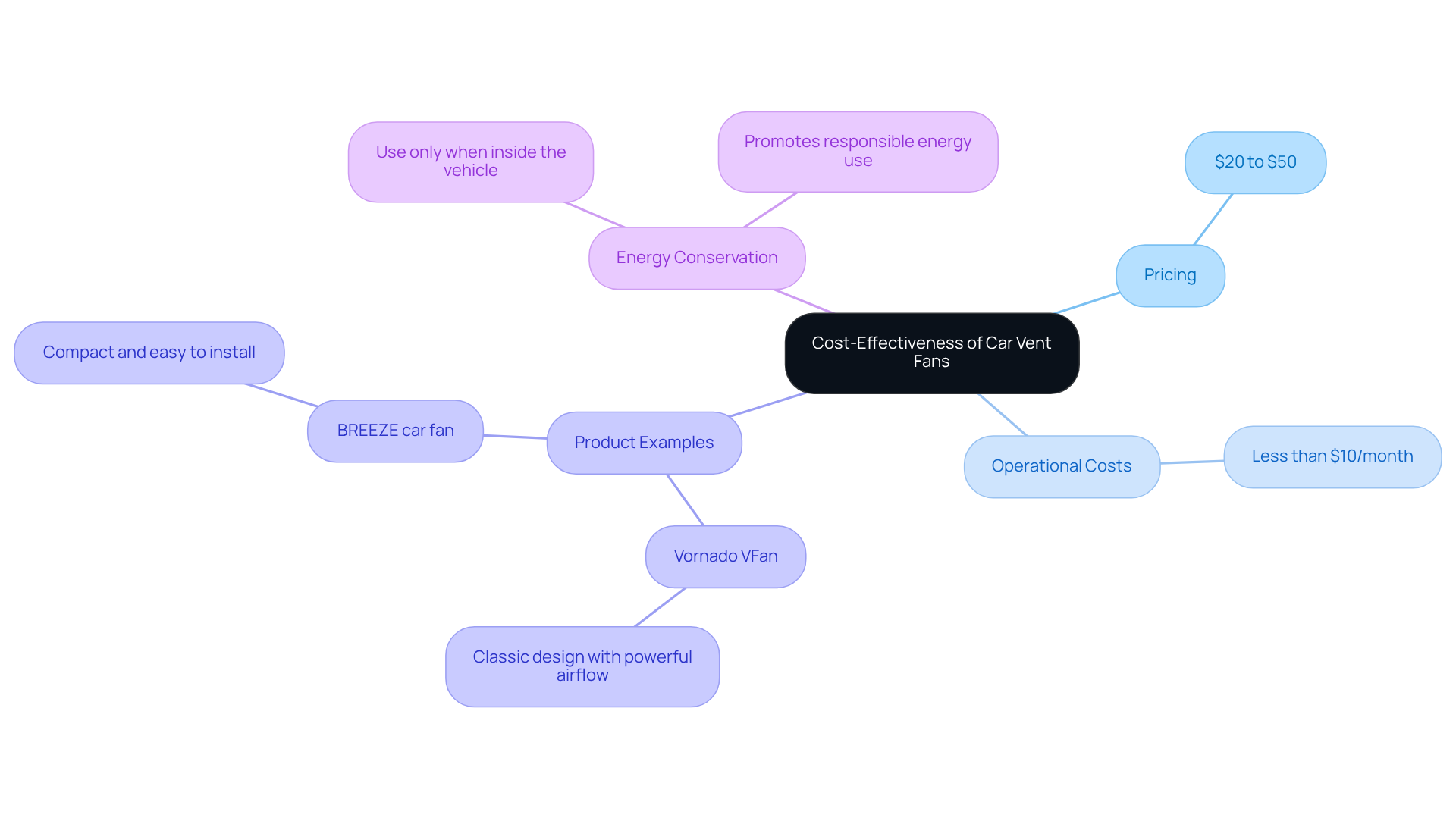
Versatility: Suitable for All Vehicle Types
Car air circulation systems, such as the car vent fan, are designed for adaptability, making them suitable for a wide range of vehicle types, including cars, trucks, SUVs, and RVs. This adaptability is essential for drivers looking to enhance comfort, whether during daily commutes or long road trips. The production of millions of car seat ventilation fan units each year highlights the significant market demand across various categories.
The automotive sector is experiencing growth, driven by rising disposable incomes and increasing vehicle ownership worldwide – key factors propelling market demand. In trucks and SUVs, where cabin space can vary greatly, the integration of vehicle air circulators ensures optimal airflow, significantly improving passenger comfort.
As the automotive industry evolves, the ability to customize accessories like ventilation systems for different models becomes increasingly important. This trend is particularly evident in the growing popularity of ventilated seats in luxury vehicles, where comfort features serve as a major selling point.
The market for car seat ventilation systems is projected to expand from USD 6.06 billion in 2025 to USD 10.08 billion by 2032, reflecting a compound annual growth rate of 7.4%. Furthermore, advancements in motor design and noise reduction technologies are enhancing the efficiency and appeal of automotive air circulation devices such as the car vent fan, solidifying their role as a vital component of modern vehicle comfort.
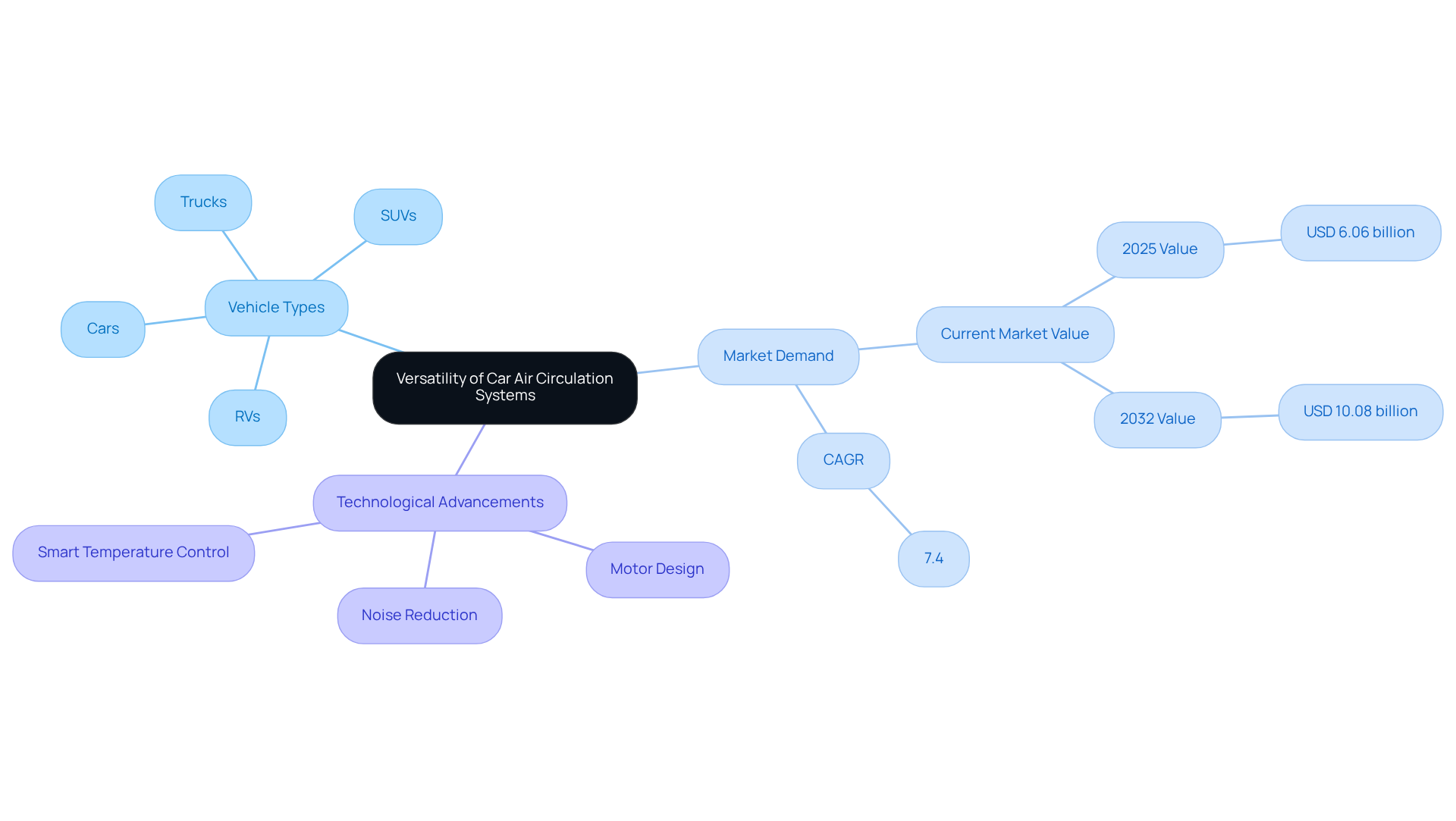
Aesthetic Appeal: Stylish Designs to Complement Your Vehicle
Contemporary auto air circulation systems present a wide array of stylish designs that can significantly enhance any car’s interior. These systems range from sleek, minimalist options to more vibrant choices, effectively combining functionality with aesthetic appeal. This dual benefit not only serves a practical purpose but also elevates the overall ambiance of the cabin, making these devices an attractive enhancement for discerning vehicle owners.
By integrating advanced technology with design, these air circulation systems, such as the car vent fan, address a common problem: maintaining a comfortable and pleasant driving environment. They ensure optimal air quality and circulation using the car vent fan, which is essential for both driver and passenger comfort. As such, investing in a modern air circulation system is not merely a choice; it’s a strategic enhancement that reflects a commitment to quality and style.
For vehicle owners looking to upgrade their interiors, installing a car vent fan offers a compelling solution. With their blend of functionality and design, they stand out as a must-have accessory that enhances both the driving experience and the vehicle’s overall aesthetic. Consider exploring the latest options available to find the perfect fit for your car.
Safety Benefits: Prevent Overheating and Enhance Driver Focus
Car air circulation systems play a vital role in preventing overheating by promoting a steady airflow, particularly during warm weather conditions. This effective airflow is essential for maintaining a cooler cabin environment, significantly reducing the risk of driver fatigue and distraction. Research underscores that a well-ventilated cabin can enhance driver focus, especially on long journeys where fatigue can lead to dangerous situations. For example, studies indicate that maintaining optimal cabin temperatures of 30 °C and vent discharge temperatures of 16.5 °C can improve driver concentration, as evidenced by a concentration level vote (CLV) of −1.78 at a cabin temperature of 35 °C without vent cooling.
Moreover, the integration of fan technology not only enhances comfort but also contributes to overall safety by ensuring that drivers remain alert and engaged. As noted by Yunchan Shin, effective air circulation is crucial for minimizing discomfort and promoting a safer driving experience, particularly in challenging conditions. It is also critical to recognize that overheating vehicles can lead to tragic outcomes, with an average of 37 child deaths per annum in the United States due to overheated cabins. Therefore, using a car vent fan is not merely a comfort element but an essential safety precaution.
To maximize the benefits of car vent fans, consider the following tips:
- Ensure proper placement for optimal airflow.
- Maintain the fans regularly to prevent obstructions.
- Monitor cabin temperatures to keep them within the ideal range.
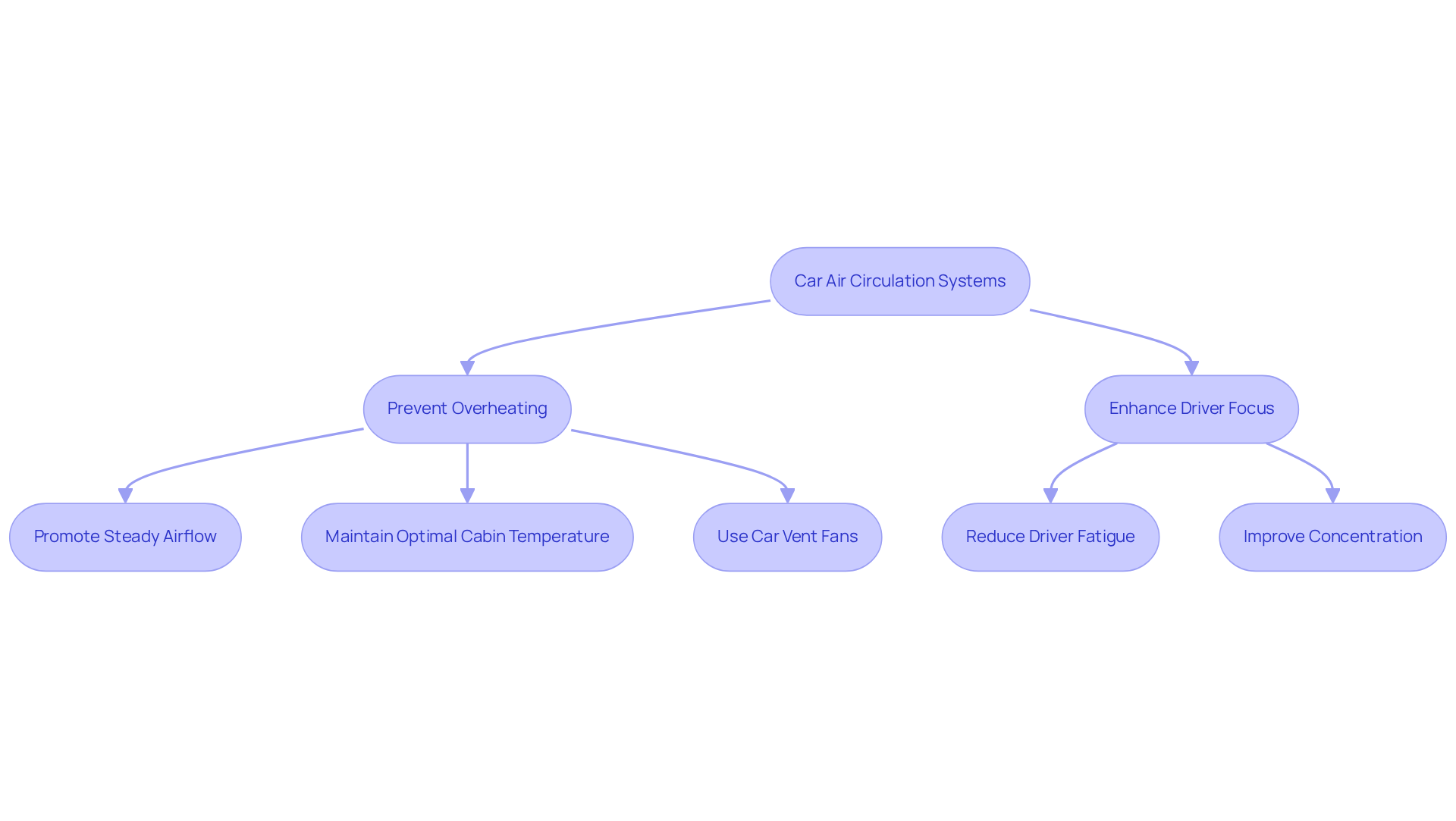
Conclusion
In conclusion, the advantages of car vent fans extend far beyond mere comfort; they embody a vital innovation in automotive design that prioritizes passenger well-being and vehicle efficiency. By enhancing airflow, regulating temperature, and improving air quality, these devices play a pivotal role in creating a more enjoyable driving experience. Their integration into modern vehicles is not merely a trend but a necessary evolution to meet the demands of today’s drivers.
Key points throughout this article have underscored how car vent fans contribute to improved air circulation, effective temperature control, and enhanced health benefits by reducing allergens and pollutants. Furthermore, their energy efficiency leads to fuel savings and a smaller environmental footprint, making them an eco-friendly choice. The convenience of installation and versatility to fit various vehicle types further solidify their appeal, while stylish designs ensure they complement any car interior.
As the automotive industry continues to innovate, embracing car vent fans is a proactive step toward enhancing comfort, safety, and sustainability. Drivers should consider these devices essential components of their vehicles, not merely accessories. By investing in car vent fans, individuals can significantly elevate their driving experience while contributing to a healthier environment and a safer journey.
Frequently Asked Questions
What is Gagner-Toomey Associates known for?
Gagner-Toomey Associates is recognized for its innovative cooling technologies that enhance comfort in automobiles, particularly through advanced systems like the car vent fan.
How do car vent fans improve vehicle comfort?
Car vent fans enhance airflow within the vehicle, actively circulating air to eliminate stale air and odors, which is crucial for maintaining a comfortable cabin temperature, especially during hot weather.
What benefits do contemporary battery cooling systems provide?
Contemporary battery cooling systems can boost energy efficiency by up to 25% and extend battery lifespan by approximately 40%, making them essential for modern automobiles.
Why is air circulation important in vehicles?
Air circulation is vital to maintain air quality inside vehicles, particularly when parked, as closed windows and off ventilation can lead to elevated pollutant levels. Car vent fans significantly improve air exchange rates, fostering a fresher atmosphere.
How do car vent fans help in heavy traffic conditions?
In heavy traffic, where air pollution can be significantly higher, car vent fans reduce the concentration of harmful particles within the vehicle, improving air quality for passengers.
What is the relationship between car vent fans and air conditioning efficiency?
Car vent fans can enhance the efficiency of the air conditioning system by allowing it to cool the cabin more effectively, particularly during heatwaves, and can lower fuel consumption when used with the air-recirculation function.
How does the car vent fan contribute to temperature control in vehicles?
The car vent fan efficiently expels hot air and draws in cooler outside air, significantly reducing cabin temperatures, especially after the vehicle has been parked in the sun.
What impact can multiple ventilation devices have on interior temperature?
Employing two ventilation devices can achieve a 17% reduction in interior temperature, while adding more blowers can provide additional temperature decreases, demonstrating the advantages of using multiple units.
What is the most effective method for energy conservation in cabin climate control?
Roof ventilation has emerged as the most effective method for energy conservation, achieving a heat removal efficiency that significantly lowers the head temperature for both the driver and rear passengers.
How do effective ventilation strategies contribute to fuel efficiency?
Effective ventilation strategies can improve fuel efficiency and enhance passenger comfort by maintaining a comfortable cabin climate, with studies showing significant temperature differences achieved through proper ventilation techniques.

